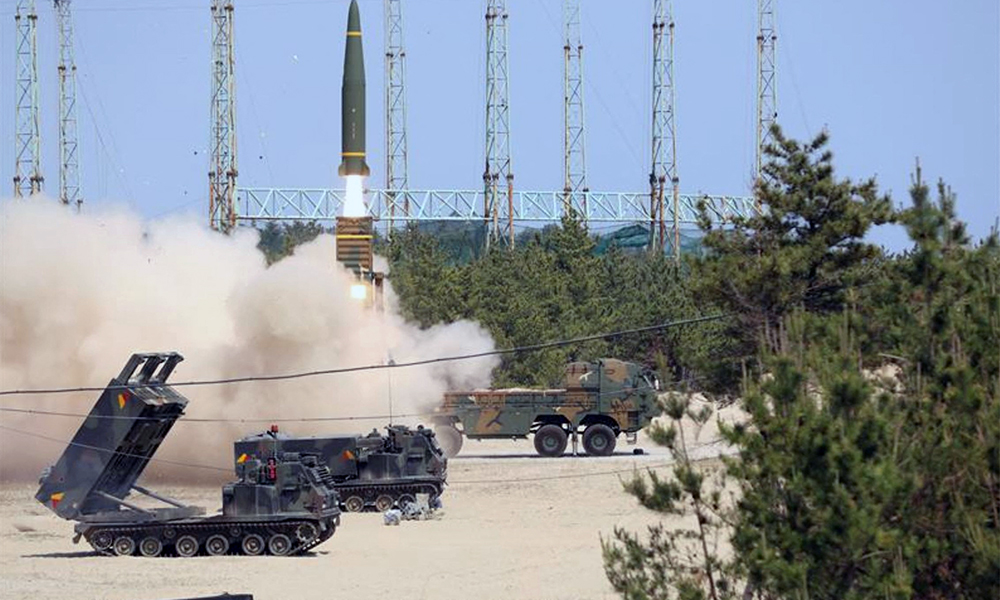Science & Technology
S.Korea, U.S. launch eight missiles in response to N.Korea missile tests

South Korea and the United States said they fired eight surface-to-surface missiles early on Monday off South Korea’s east coast, responding to a barrage of short-range ballistic missiles launched by North Korea on Sunday.
The action is a demonstration of “the capability and readiness to carry out precision strikes” against the source of North Korea’s missile launches or the command and support centres, South Korea’s Yonhap news agency cited the South Korean military as saying.
South Korean President Yoon Suk-yeol, who took office last month, has vowed to take a tougher line against the North and agreed with U.S. President Joe Biden at a May summit in Seoul to upgrade joint military drills and their combined deterrence posture.
North Korea has conducted a flurry of missile launches this year and Yoon said its missile and nuclear weapons programmes have reached a level at which they pose a threat to regional and world peace.
The South “will continue to build fundamental and practical security capabilities and deter the North’s nuclear and missile threats,” Yoon said at an event for South Korea’s Memorial Day.
The militaries of South Korea and the United States fired eight surface-to-surface missiles over about 10 minutes starting at 4:45 a.m. on Monday (1945 GMT Sunday) in response to the eight missiles fired by the North on Sunday, Yonhap reported.
An official from South Korea’s Defence Ministry confirmed eight Army Tactical Missile Systems (ATACMS) had been fired.
U.S. Indo-Pacific Command said the exercise included one U.S. Army missile and seven from South Korea.
“The ROK-U.S. Alliance remains committed to peace and prosperity on the Korean Peninsula and throughout the Indo-Pacific,” it said in a statement, using the initials of South Korea’s official name.
North Korea’s short-range ballistic missiles, fired toward the sea off its east coast on Sunday, were probably its largest single test and came a day after South Korea and the United States ended joint military drills.
The South Korea-U.S. bilateral exercises involved an American aircraft carrier for the first time in more than four years.
Japan and the United States also conducted a joint military exercise on Sunday in response to the latest North Korea missile tests.
North Korea, which is several weeks into battling its first known outbreak of COVID-19, has criticised previous joint drills as an example of Washington’s continued “hostile policies” toward Pyongyang, despite its talk of diplomacy.
Yonhap, citing an unidentified source, said the North’s volley on Sunday was launched from four locations, including Sunan in the capital, Pyongyang.
Leif-Eric Easley, an international studies professor at Ewha University in Seoul said South Korea’s current missile defences are insufficient against the expanding North Korean threat.
“This calls not only for further investments in hardware but also a more multilayered approach coordinated with Japan and diplomatic efforts with Beijing to reduce arms race dynamics with Pyongyang.”
North Korea continued with its recent trend of not reporting on missile launches in state media, which some analysts have said is meant to show the tests are part of routine military drills.
Washington and Seoul officials also recently warned North Korea appeared ready to resume nuclear weapons tests for the first time since 2017.
Last month, North Korea fired three missiles, including one thought to be its largest ICBM, the Hwasong-17, after Biden ended an Asia trip where he agreed to new measures to deter the nuclear-armed state.
Joint South Korean and U.S. forces fired missiles in response to those tests too, which the two allies say are violations of U.N. Security Council resolutions.
Last month, the United States called for more U.N. sanctions on North Korea over its ballistic missile launches, but China and Russia vetoed the suggestion, publicly splitting the U.N. Security Council on North Korea for the first time since it started punishing it in 2006, when North Korea conducted its first nuclear test.
Science & Technology
Australia social media ban set to take effect, sparking a global crackdown
For the social media businesses, the implementation marks a new era of structural stagnation as user numbers flatline and time spent on platforms shrinks, studies show.

Australia is set to become the first country to implement a minimum age for social media use on Wednesday, with platforms like Instagram, TikTok and YouTube forced to block more than a million accounts, marking the beginning of an expected global wave of regulation.
From midnight, 10 of the biggest platforms will be required to block Australians aged under 16 or be fined up to A$49.5 million ($33 million), Reuters reported.
The law received harsh criticism from major technology companies and free speech advocates, but was praised by parents and child advocates.
The rollout closes out a year of speculation about whether a country can block children from using technology that is built into modern life. And it begins a live experiment that will be studied globally by lawmakers who want to intervene directly because they are frustrated by what they say is a tech industry that has been too slow to implement effective harm-minimisation efforts.
Governments from Denmark to Malaysia – and even some states in the U.S., where platforms are rolling back trust and safety features – say they plan similar steps, four years after a leak of internal Meta (META.O) documents showed the company knew its products contributed to body image problems and suicidal thoughts among teenagers while publicly denying the link existed.
“While Australia is the first to adopt such restrictions, it is unlikely to be the last,” said Tama Leaver, a professor of internet studies at Curtin University.
“Governments around the world are watching how the power of Big Tech was successfully taken on. The social media ban in Australia … is very much the canary in the coal mine.”
A spokesperson for the British government, which in July began forcing websites hosting pornographic content to block under-18 users, said it was “closely monitoring Australia’s approach to age restrictions.”
“When it comes to children’s safety, nothing is off the table,” they added.
Few will scrutinise the impact as closely as the Australians. The eSafety Commissioner, an Australian regulator tasked with enforcing the ban, hired Stanford University and 11 academics to analyse data on thousands of young Australians covered by the ban for at least two years.
Though the ban covers 10 platforms initially, including Alphabet’s (GOOGL.O), YouTube, Meta’s Instagram and TikTok, the government has said the list will change as new products appear and young users switch to alternatives.
Of the initial 10, all but Elon Musk’s X have said they will comply using age inference – guessing a person’s age from their online activity – or age estimation, which is usually based on a selfie. They might also check with uploaded identification documents or linked bank account details.
Musk has said the ban “seems like a backdoor way to control access to the internet by all Australians” and most platforms have complained that it violates people’s right to free speech.
For the social media businesses, the implementation marks a new era of structural stagnation as user numbers flatline and time spent on platforms shrinks, studies show.
Platforms say they don’t make much money showing advertisements to under-16s, but they add that the ban interrupts a pipeline of future users. Just before the ban took effect, 86% of Australians aged 8 to 15 used social media, the government said.
“The days of social media being seen as a platform for unbridled self-expression, I think, are coming to an end,” said Terry Flew, the co-director of University of Sydney’s Centre for AI, Trust and Governance.
Platforms responded to negative headlines and regulatory threats with measures like a minimum age of 13 and extra privacy features for teenagers, but “if that had been the structure of social media in the boom period, I don’t think we’d be having this debate,” he added.
Science & Technology
Ethiopian volcano erupts for first time in nearly 12,000 years
Ash from the eruption drifted across the region, spreading over Yemen, Oman, India, and parts of Pakistan.

The Hayli Gubbi volcano in Ethiopia’s Afar region has erupted for the first time in almost 12,000 years, sending massive ash plumes soaring up to 14 kilometres into the atmosphere, according to the Toulouse Volcanic Ash Advisory Centre.
The eruption began on Sunday and lasted several hours. Hayli Gubbi, located around 800 kilometres northeast of Addis Ababa near the Eritrean border, sits within the geologically active Rift Valley, where two major tectonic plates meet. The volcano rises roughly 500 metres above the surrounding landscape.
Ash from the eruption drifted across the region, spreading over Yemen, Oman, India, and parts of Pakistan. Satellite imagery and social-media videos captured a towering column of white smoke billowing into the sky.
The Smithsonian Institution’s Global Volcanism Program notes that Hayli Gubbi has no recorded eruptions during the Holocene, the period dating back about 12,000 years to the end of the last Ice Age.
Volcanologist Simon Carn of Michigan Technological University also confirmed on Bluesky that the volcano had “no record of Holocene eruptions.”
Science & Technology
Cloudflare outage easing after millions of internet users affected

A global outage at web-infrastructure firm Cloudflare began to ease on Tuesday afternoon after preventing people from accessing major internet platforms, including X and ChatGPT.
Cloudflare, whose network handles around a fifth of web traffic, said it started to investigate the internal service degradation around 6:40 a.m. ET. It has deployed a fix but some customers might still be impacted as it recovers service.
The incident marked the latest hit to major online services. An outage of Amazon’s cloud service last month caused global turmoil as thousands of popular websites and apps, including Snapchat, were inaccessible due to the disruption.
Cloudflare – whose shares were down about 5% in premarket trading – runs one of the world’s largest networks that helps websites and apps load faster and stay online by protecting them from traffic surges and cyberattacks.
The latest outage prevented users from accessing platforms such as Canva, X, and ChatGPT, prompting users to log outage reports with Downdetector.
Downdetector tracks outages by collating status reports from a number of sources. “We saw a spike in unusual traffic to one of Cloudflare’s services beginning at 11:20 UTC. That caused some traffic passing through Cloudflare’s network to experience errors,” the company said in an emailed statement.
“We are all hands on deck to make sure all traffic is served without errors.”
X and ChatGPT-creator OpenAI did not immediately respond to requests for comment. – REUTERS
-

 International Sports5 days ago
International Sports5 days agoIPL 2026: Teams take shape after auction as franchises balance star power and depth
-

 International Sports5 days ago
International Sports5 days agoILT20: Abu Dhabi Knight Riders end Desert Vipers’ unbeaten run in dramatic one-run win
-

 Latest News3 days ago
Latest News3 days agoAfghan border forces prevent illegal entry of hundreds into Iran
-

 Latest News2 days ago
Latest News2 days agoPakistan summons Afghan diplomat over deadly attack in North Waziristan
-

 Business5 days ago
Business5 days agoMahirood Customs leads Iran’s exports to Afghanistan
-

 Latest News5 days ago
Latest News5 days agoAfghanistan, Kyrgyzstan discuss expanding trade and economic cooperation
-

 Latest News3 days ago
Latest News3 days agoJapan allocates nearly $20 million in humanitarian aid for Afghanistan
-

 Latest News2 days ago
Latest News2 days agoKarzai urges reopening of girls’ schools and universities for Afghanistan’s bright future
























